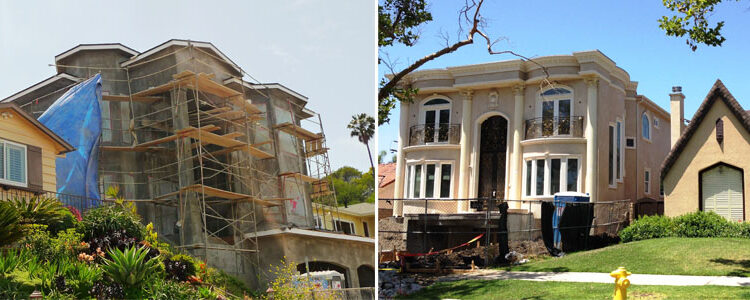
Baseline Mansionization Ordinance (BMO)
What is the BMO?
The Baseline Mansionization Ordinance (BMO) regulates the scale of new construction in single-family residential neighborhoods in the City of Los Angeles. The ordinance encourages the retention of existing homes and limits the size, height, and mass of new houses in order to encourage greater compatibility.
What does the BMO mean for me?
As a citywide policy, the BMO helps protect and sustain the character of older and historic neighborhoods throughout Los Angeles:
- Reduced "bulk," including limits on attached garages, breezeways, and covered porches, means that new houses will be appropriately scaled, as opposed to looming over their neighbors.
- Scaled-down homes offer greater access to natural light, air, and privacy.
- Street trees won't be removed to accommodate enlarged driveways or construction equipment.
- Design standards, such as front facade articulation and setbacks for balconies and terraces, will help prevent the construction of "boxy" homes.
- Greater assurances over future development help stabilize property values.
Background
The City of Los Angeles first passed the Baseline Mansionization Ordinance (BMO) in 2008 and the Baseline Hillside Ordinance (BHO) in 2011.
The legislation represented a direct response to mansionization and teardown trends in older and historic neighborhoods throughout Los Angeles. With boxy and out-of-scale homes replacing much of the city's existing single-family housing stock, the BMO provided a framework for ensuring that new development respected its existing context.
The BMO and BHO sought to regulate the size and scale of new construction in single-family residential and hillside neighborhoods, respectively. Neighborhood concerns included new building mass; scale of driveways and garages; loss of natural light, air, and privacy; extensive hillside grading; and removal of street trees.
Yet a few provisions in the BMO, including exemptions and design bonuses, actually encouraged the kind of out-of-scale homes it was designed to prevent. The ordinance, for example, allowed for twenty to thirty percent increases in square footage if the new home included environmentally-friendly materials and features.
Though certain neighborhoods, including Historic Preservation Overlay Zones (HPOZs) and those protected by an Interim Control Ordinance (ICO), benefit from stronger controls on demolition and new construction, the BMO is the primary conservation tool for all other single-family, R-1 zoned neighborhoods citywide.
On May 1, 2014, Los Angeles City Councilmember Paul Koretz introduced a motion directing the Department of City Planning to address the shortcomings in the BMO/BHO by doing four primary things:
- Re-evaluating Residential Floor Area exemptions;
- Re-evaluating design bonuses;
- Removing the green building bonus and loophole; and
- Reducing R1-Zone Residential Floor Area and allowable size of new residential construction.
The City introduced the first revisions to the BMO/BHO in October 2015, followed by a second update in April 2016. The Planning Department convened four public meetings regarding the amendments in May 2016 and released the Initial Study/Negative Declaration (environmental review documents) in June 2016.
Following numerous public hearings, City Council adopted the revisions to the BMO/BHO in March 2017. Though the amended ordinances are not perfect, this is an important step in the right direction and a huge win for L.A. neighborhoods.
Learn more about mansionization and teardown trends in Los Angeles >>
Click here to view a presentation to the City Planning Commission on the BMO/BHO (July 2016) >>
Read more about the BMO from the Office of Historic Resources >>